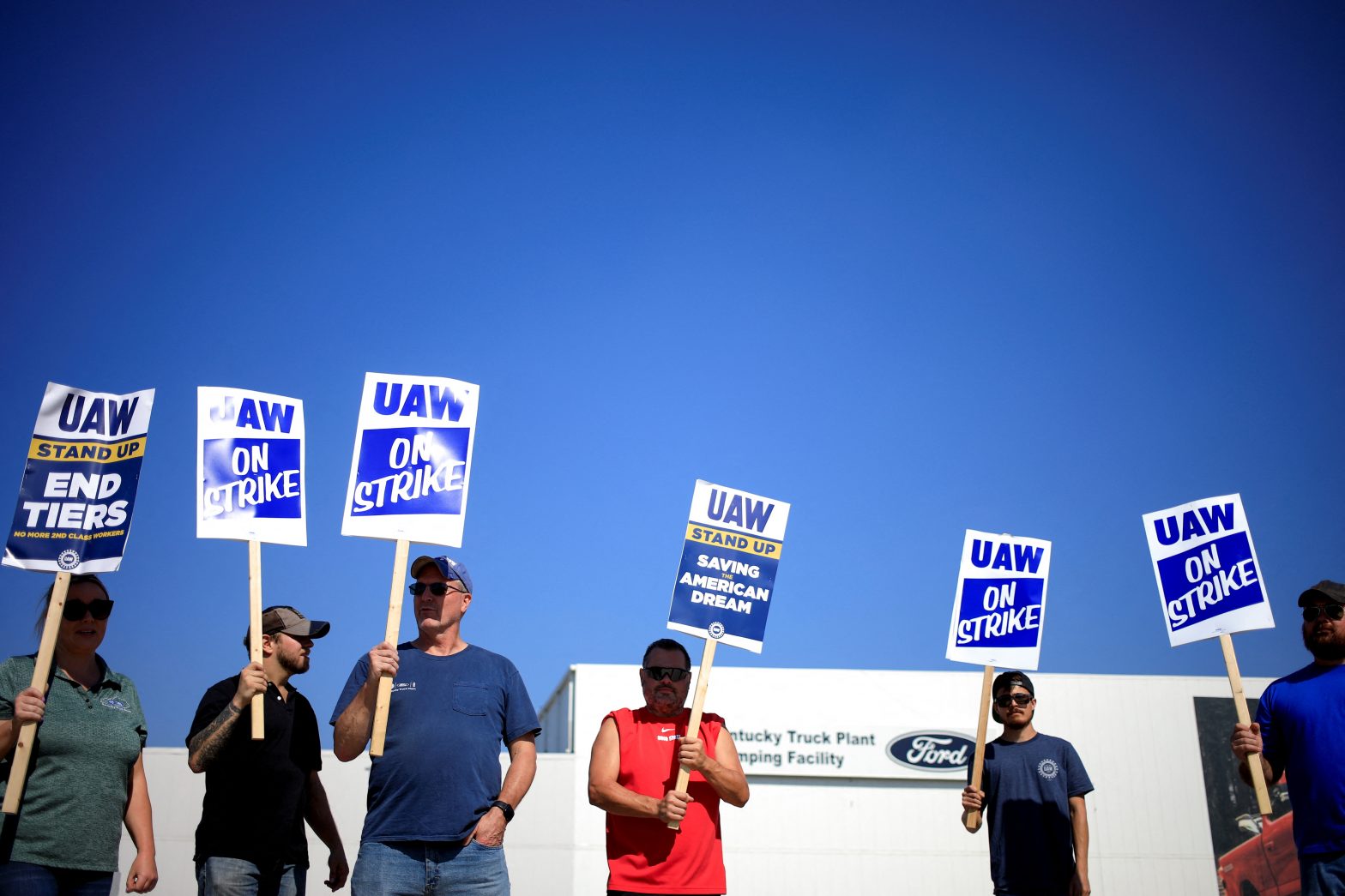
United Auto Workers (UAW) union members picket outside Ford’s Kentucky truck plant after going on strike in Louisville, Kentucky, U.S. October 12, 2023. REUTERS/Luke Sharrett/File Photo Acquire Licensing Rights
Oct 24 (Reuters) – The United Auto Workers (UAW) union struck a General Motors (GM.N) assembly plant in Texas on Tuesday that builds the U.S. automaker’s profitable full-size sport utility vehicles, in another significant expansion of the strike.
The UAW said another 5,000 workers are going on strike, bringing the total number of UAW members on strike at the Big Three automakers to over 45,000, on day 40 of the strike.
The workers took the strike to Arlington Assembly, home to some of GM’s most profitable vehicles, the Chevy Tahoe, Chevy Suburban, GMC Yukon and Cadillac Escalade. With that, UAW has now shut down three of the most profitable auto factories in the world, including Ford’s (F.N) Kentucky Truck heavy duty pickup factory and Chrysler-owner Stellantis’ (STLAM.MI) Ram pickup plant in Sterling Heights, Mich.
The union’s strategy of targeted strikes has throttled billions in revenue for the Detroit Three while requiring fewer than half the 150,000 UAW members at the companies to forgo pay and walk picket lines.
GM earlier on Tuesday reported a stronger-than-expected third-quarter profit but withdrew its full-year financial forecast due to the uncertainty of the strike.
“Another record quarter, another record year. As we’ve said for months: record profits equal record contracts,” said UAW President Shawn Fain. “It’s time GM workers, and the whole working class, get their fair share.” He on Friday indicated that a settlement could be near but that negotiations could get tougher, calling talks before a deal “the hardest part of a strike.”
The union initially demanded a 40% wage hike over four-and-a-half years, including a 20% immediate increase, improvements in benefits, as well as covering EV battery plant workers under union agreements.
UAW chief Fain on Friday said the Detroit Three had converged on a 23% wage hike offer and made progress on other issues. But he told UAW members “there is more to be won”. GM and Ford had said additional cost-of-living increases already take their total compensation offers to over 30%.
The UAW and the automakers are also bargaining over future wages and unionization policies for electric vehicle battery plants planned by joint ventures of the automakers and their South Korean battery partners.
“Pulling Arlington out on GM earnings day was meant to emphasize, as if it needed any emphasis, that there are real economic costs” to the strike, University of California Berkeley labor professor Harley Shaiken said.
“Each plant is an escalation. That positively could indicate the endgame. The union is playing its cards with the goal of a settlement sooner rather than later. Pulling out the profitable plants is meant to hasten the settlement.”
Those talks are complicated, because the ventures are separate companies and the automakers do not have to cover them under their master UAW contracts under U.S. labor law.
“We are disappointed by the escalation of this unnecessary and irresponsible strike. It is harming our team members who are sacrificing their livelihoods and having negative ripple effects on our dealers, suppliers, and the communities that rely on us,” GM said in a statement.
GM Chief Executive Mary Barra told investors on Tuesday the company “will not agree to a contract that isn’t responsible to our employees and our shareholders.”
Prior to the expansion to the Arlington plant, GM said the strike had cost it about $800 million in profits and could cost it another $200 million per week assuming no additional plants walked out.
After five week of strikes, the economic losses for the auto industry had crossed $9.3 billion, Anderson Economic Group LLC estimated on Monday.
Shares in GM, Ford and Stellantis were little changed on Tuesday.
Reporting by David Shepardson and Joe White; Additional reporting bys Ben Klayman in Detroit; Writing by Sayantani Ghosh; Editing by Chizu Nomiyama and Peter Henderson
Our Standards: The Thomson Reuters Trust Principles.
